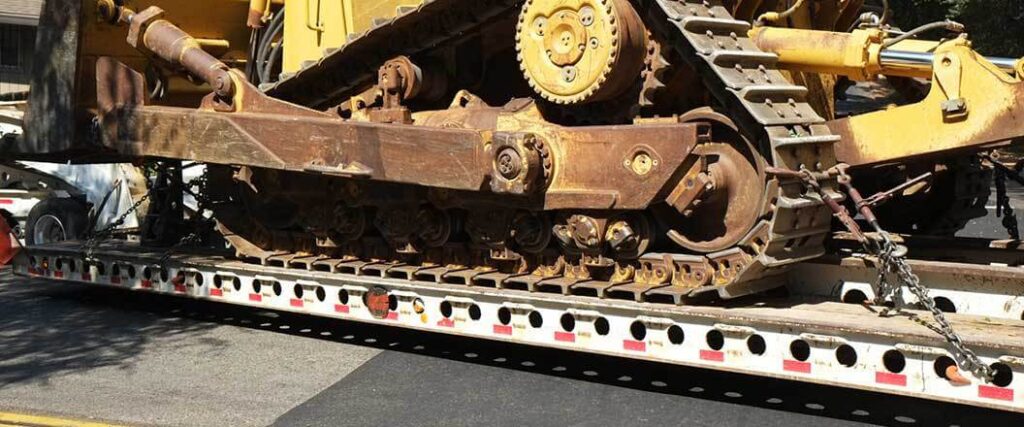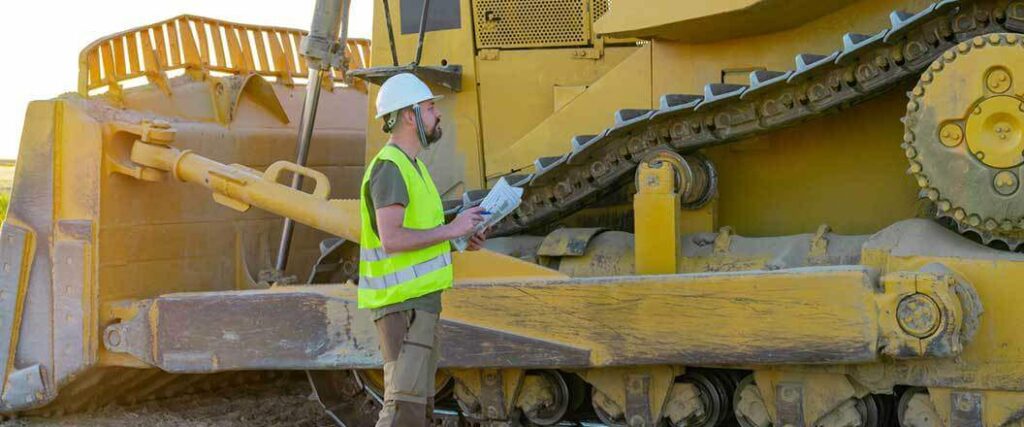Bulldozer transport is a task that requires a lot of planning and coordination. Fortunately, bulldozers are transported across the U.S. to construction sites on a fairly regular basis. That means performing this arduous task is well within your capabilities.
The Department of Transportation is the agency whose regulations must be followed by shippers. Bulldozer transport is completed by loading the bulldozer onto a flatbed trailer. Different equipment is used to secure the bulldozer to the trailer. Bulldozers are unloaded by being driven off of the trailer that transported them.
Despite bulldozer transport sounding like a simple process, there are quite a few facets to it that you’ll need to understand as a shipper. We’ll cover these details so you can ship your bulldozer without issue.

Bulldozers are a type of heavy equipment that comes in a few different varieties. The trailer used to transport your dozer may change based on the classification that your dozer falls under.
These classifications are:
Since these dozers can vary in size and weight, many different companies that manufacture these vehicles use their own metrics to differentiate between each one. For example, Caterpillar, the construction equipment manufacturer, distinguishes the weight of their dozers using these metrics.
Be sure to check with the manufacturer for exact specifications and weight classes if they are different from the ones we’ve listed as an example. It’s likely that your dozer falls into one of these weight ranges or one that’s fairly similar.
The weight of your dozer will determine which type of trailer should be used during the transportation process. We’ve explained the different classifications of dozers and the trailers that are compatible with them in the following sections.

We follow best practices to get your bulldozer moving on schedule! Get a personalized quote from our industry experts.
The first type of bulldozer we’ll discuss is the crawler dozer, also known as the tracked bulldozer. Due to the large treads on either side of it, this type of dozer resembles a tractor. These treads are also what gives it the ability to move through rough terrain while moving materials over a considerable distance.
Some of the best conditions for crawler dozers to be used are:
On the rear of these vehicles is a bulldozer attachment called a ripper which is used to crush extremely hard surfaces. Crawlers can also come in a variety of sizes, making them a great tool to use in both small and large operations.
Because the size of crawler dozers varies, so too does their weight. Each flatbed trailer has a different weight capacity which gives shippers the flexibility to move whatever type of bulldozer they have. Regardless of how much your crawler bulldozer weighs, you’ll be able to find a flatbed trailer that will be able to transport it for you.
Wheel dozers or tire dozers are pretty similar to crawlers, except that they have tires rather than tracks among other differences. The tires give wheel dozers better maneuverability than crawlers and even have the added benefit of completely articulated hydraulic steering.
Wheel dozers are often used for the following constructions ties:
The tires of wheel dozers make them suitable for softer and more sensitive ground compared to that crawler bulldozers. Even the smallest wheel dozers tend to be heavier than the small crawlers. Therefore, you’ll need one of the flatbeds that we listed previously to move this type of dozer for shipping.
While mini dozers look similar to crawlers, the purposes that they’re used for are quite different. Also called compact bulldozers, these types of heavy equipment are used for the easiest types of construction work.
The most ideal construction work for mini bulldozer include:
Thanks to their smaller size, mini dozers are excellent pieces of equipment for smaller construction projects like these. Mini dozers can be transported by flatbed trailers that have smaller weight capacity limits, and might not even need a heavy haul permit.
Our article on transporting construction equipment will help if you need to ship something other than a bulldozer.

Now that you know what type of bulldozer you’re shipping and the trailer that will be used to transport it, you can move on to the preparation part of the shipping process.
To prepare your bulldozer for shipping, you’ll need to obtain an oversize load permit and figure out what route will be safe enough for your freight to travel.
Let’s review the needs of each and what challenges you may need to overcome.
Shipping oversized freight like bulldozers will require obtaining an oversized permit. Each state in the U.S. has its own Department of Transportation (DOT). State DOTs are the institutions which you’ll apply and receive an oversized permit from. You’ll need to obtain one oversize load permit for each state that your bulldozer will be transported through.
State oversize permits will require information about your load like:
Oversize permits typically come with a fee attached to them. States also give shippers the option of obtaining a single-trip permit or an annual permit.
It’s important to note that not all bulldozers will require an oversize load permit. Mini dozers are less likely to need a loading permit since they’re smaller and weigh far less than other dozers.
Once you have the permit(s) for your oversize bulldozer load, you’ll need to start planning the route for it to travel. Route planning is simply choosing a route ahead of time that will accommodate the dimensions of your load for the entire length.
It’s unlikely that special routes will need to be taken when transporting small crawler dozers and mini dozers. That said, larger dozers will require routes that will make transporting them as safe as possible.
Some things that should be considered when planning a route are:
Bridge clearance is really important to consider because dozers that are extremely tall will need to be able to make it under them. Sharp turns can be dangerous because a semi-truck hauling a large and heavy dozer may have trouble performing such a turn. Any piece of heavy machinery on a flatbed trailer, such as an excavator, would face similar issues.
The roads and highways themselves are important to consider as well. Some states prohibit the transportation of oversized freight on specific roadways during certain holidays. Every state is different which is why researching the regulations of each before shipping is important.
Our article on heavy haul shipping regulations will provide you with more details on permits and trip planning.

Reach out to us at (855) 490-2433 or fill out our quick form and a live agent will be in touch shortly.
With your permit ready and a route planned, you can now move on to the loading and unloading process. No receiver wants to get a dozer that’s damaged or outright broken.
As with preparing a dozer for shipping, loading and unloading the dozer correctly helps ensure that it’s in working order when it arrives at a construction site.
There are a few preparations your bulldozer will have to go through before it’s ready to be loaded and shipped off. While this process is tedious, it’s a necessary part of shipping a bulldozer.
The preparations that you should check off before loading the bulldozer include:
All of these preparations will give your bulldozer a new and fresh look when it arrives at its destination.
Loading a bulldozer onto a trailer is an extremely dangerous process. Following all of the safety precautions will help prevent any accidents from occurring while the bulldozer is being transported. To load a bulldozer, there are three different loading methods that can be used.
These methods are:
More often than not, a bulldozer will be driven onto a flatbed trailer with a removable gooseneck. This method is much more self-sufficient because it requires less equipment for loading to be performed. Additionally, most dozers are too heavy for forklifts and even cranes to be lifted and placed onto a flatbed.
If the attachments for the bulldozer have to be shipped separately from the rest of the bulldozer, then the crane or forklift loading method will be used. Bulldozer attachments are heavy, but still much lighter than the machine itself.
After your bulldozer and any attachments (if applicable) are placed on a flatbed trailer, you’ll need to secure them firmly to the trailer to keep them from shifting or moving. This is done using a multitude of different types of equipment.
The equipment used includes:
Bulldozers with wheels will need chocks, cradles, and wedges to help keep them from rolling. Chains will need to be used to provide extra security to the bulldozer. When placing chains on your bulldozer and equipment, make sure that you secure the chains tightly, but not too tight so that you cause damage to the bulldozer itself.
Unloading your bulldozer will be the final step of the transportation process. For the unloading proceedings, you will essentially be required to do everything we’ve already covered, but in reverse.
Unloading is completed using the following steps:
The unloading process can be even more dangerous than loading. Therefore, following all safety guidelines correctly is vital to the safety of all those involved in unloading. Look into our article on how to transport a shipping container if you need to move cargo quickly from a port.

You’ll be doing a little bit of waiting when your bulldozer finally hits the road. The wait time can change based on how far your bulldozer will have to travel.
To give you an idea of how long you’ll be waiting, we’ve created a table of the estimated wait times based on the distance of the journey.
| Distance | Transit Time (Estimate) |
| 0-200 Miles | 1-3 Days |
| 200-500 Miles | 2-4 Days |
| 500-1000 Miles | 3-6 Days |
| 1000-1500 Miles | 4-7 Days |
| 1500-2000 Miles | 5-8 Days |
| 2000-2500 Miles | 6-9 Days |
| 2500+ Miles | 7-10 Days |
Runtimes for the state or states that your bulldozer has to travel through may also cause these estimated wait times to change as well. A state's runtime is essentially the hours that oversize freight like bulldozers can travel. Based on how strict the regulations are, you should expect your freight to arrive within the estimated time span for each distance, or a bit longer.

Giving an exact number to how much it costs to move a bulldozer is difficult since every load is different. Most transport companies charge $3 per mile for these types of shipments.
This rate can change due to a variety of factors such as:
Another cost to consider when shipping is the amount of money you’ll have to spend to obtain an oversize load permit. You can obtain an oversize load permit for your bulldozer shipment yourself or the carrier will obtain one for you. Carriers that obtain permits for their customers will add the expenses to apply and obtain the permit into the total cost to ship their load.
Lastly, the cost of labor to load and unload is another factor that can have an impact on how much you spend to ship your freight. Labor costs for loading and unloading will vary from company to company as well.
If you need to move another type of heavy freight, check out our article on oversized cargo transportation for the basics.
Here at Heavy Haul & Oversized, transporting bulldozers is a task we’ve completed many times in the past. Due to our experience moving bulldozers, we know all the best practices for loading, securing, and unloading them from their trailer. We offer flatbed shipping that will be able to accommodate your bulldozer, regardless of its dimensions or weight.
These trailers include:
If you’re ready to get your bulldozer shipped then fill out your quote below or call us at (855) 490-2433 for more information.
Heavy Haul and Oversized
315 NE 14th Street #4122
Ocala, FL 34470